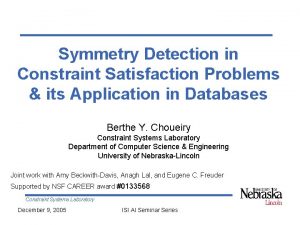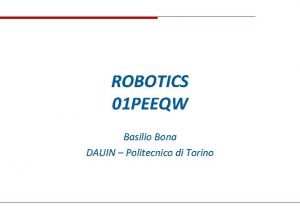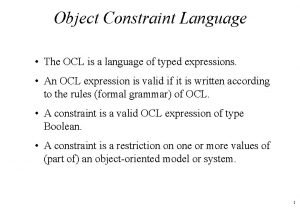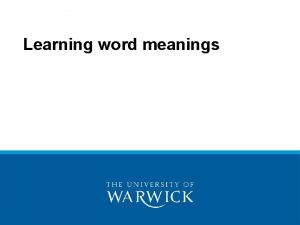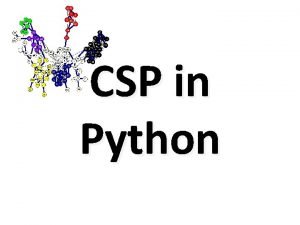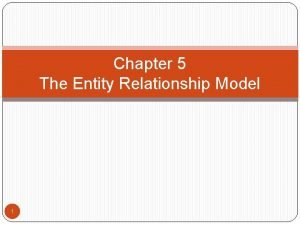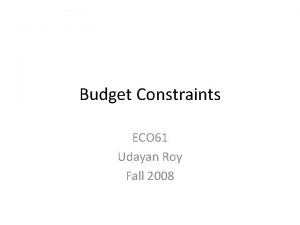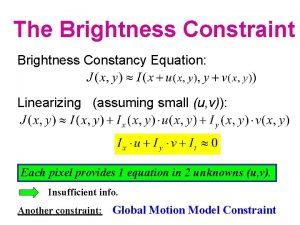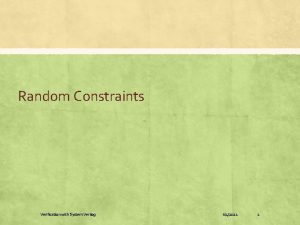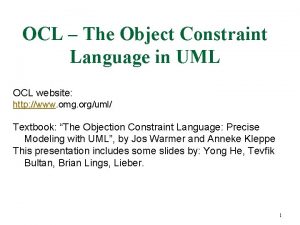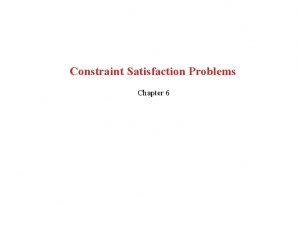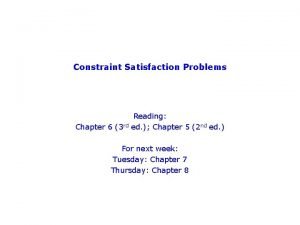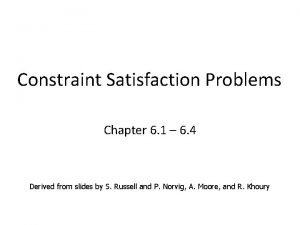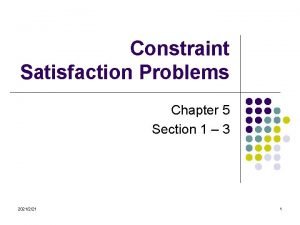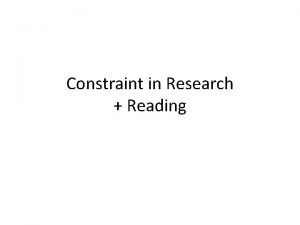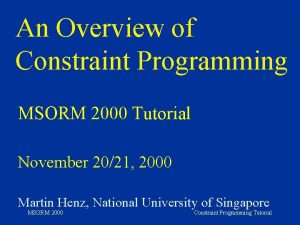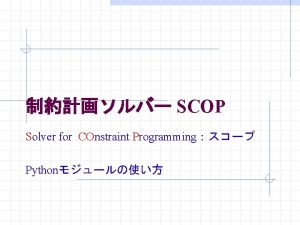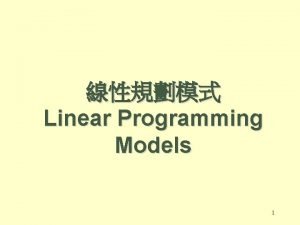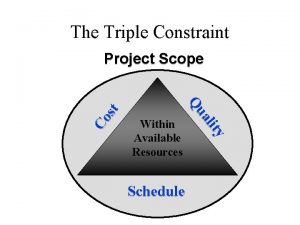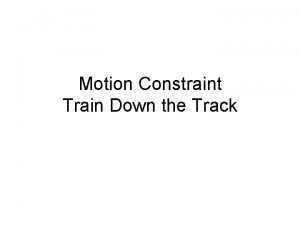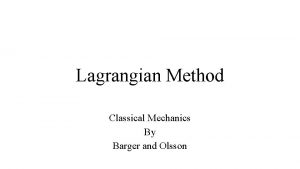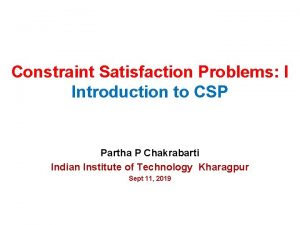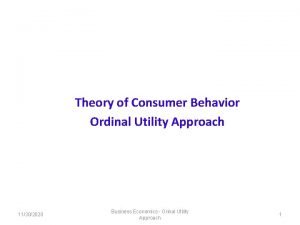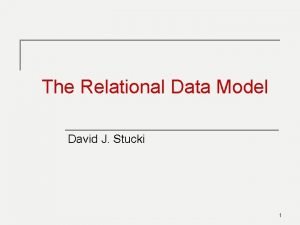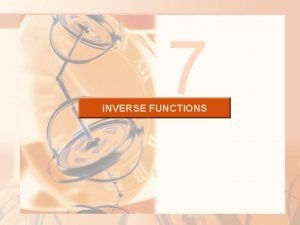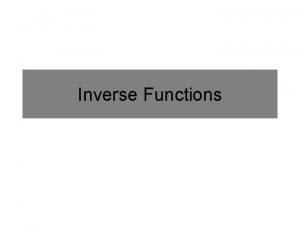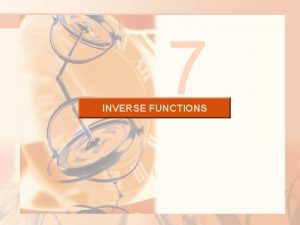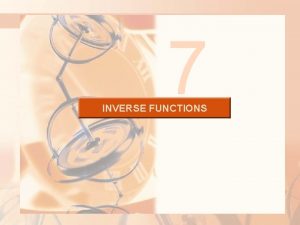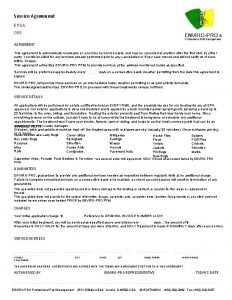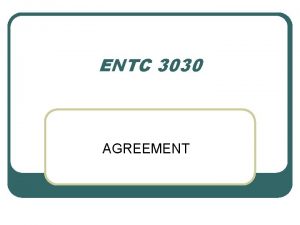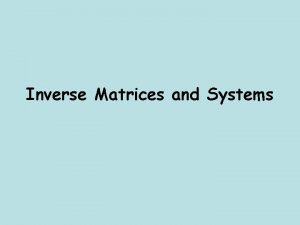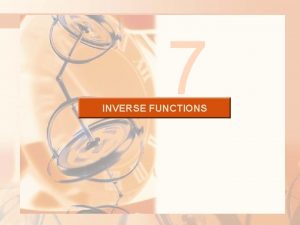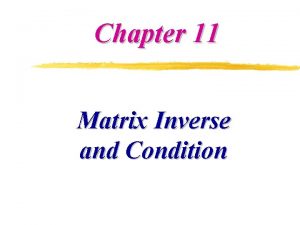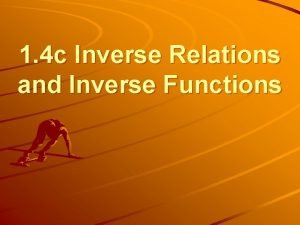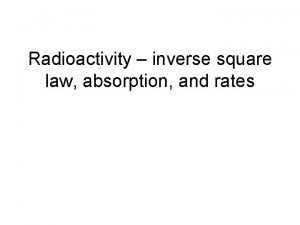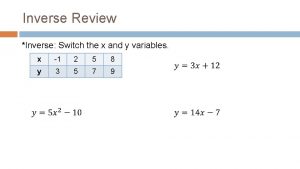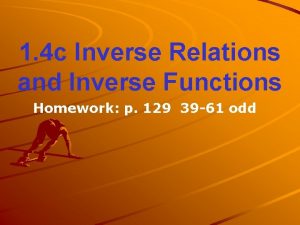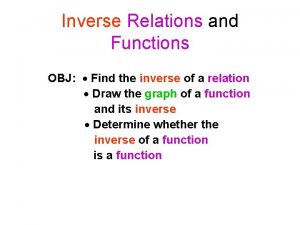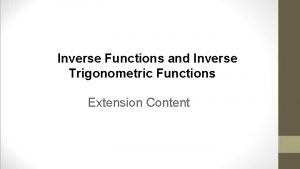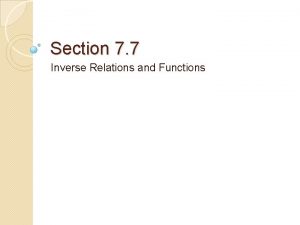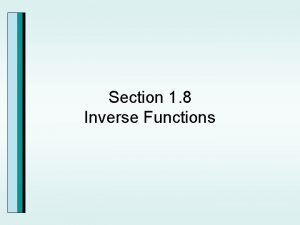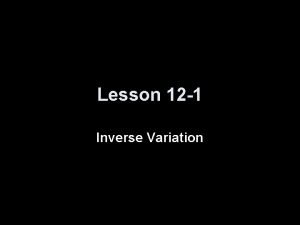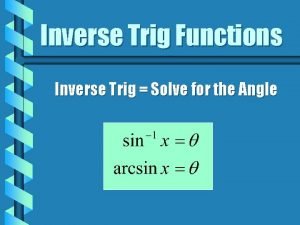The PersonCase Constraint and the Inverse Agreement Constraint













































- Slides: 45

The Person–Case Constraint and the Inverse Agreement Constraint in Uralic Katalin É. Kiss Research Institute for Linguistics of the Hungarian Academy and Pázmány P. University

Claims • The Inverse Agreement Constraint and the Person–Case Constraint in Uralic are manifestations of the same Inverse Topicality Constraint. • Alternative analyses of the PCC, e. g. , those deriving it from the mechanism of Multiple Agree, cannot account for the whole range of data attested.

Road map 1. The Inverse Agreement Constraint in Uralic 2. The Inverse Agreement Constraint is an Inverse Topicality Constraint restricting DOM 3. The Person-Case Constraint in Uralic: another Inverse Topicality Constraint restricting DOM 4. Formal theories of the PCC 5. Uralic facts resisting the formal explanations

1. The Inverse Agreement Constraint in Uralic Hungarian: Verbal agreement with 3 rd person objects; no agreement with 1 st/2 nd person objects (1) János John (2) János John (3) János John lát-ja-Ø őt/őket. see-OBJ-3 SG him/them lát-Ø engem/minket. see-3 SG me/us lát-Ø téged/titeket. see-3 SG yousg/youpl

A weak (relativized) constraint: S 3 < O 2: (4) Ő he lát-Ø see-3 SG téged. you. ACC S 1 > O 2: (5) Én I lát-l-ak see-2 OBJ-1 SG téged. you. S 3 < O 1: (6) Ő he lát see. 3 SG engem. me S 2 < O 1: (7) Te lát-sz you see-2 SG engem. you. ACC

Same person, SG subject, PL object: Agr S 1 sg > O 1 pl: O-V agr (8)a. Én minket ajánl-om /*ajánl-ok. I us recommend-OBJ. 1 SG/recommend-1 SG ‘I recommend us. ’ S 2 SG > O 2 PL: O-V agr b. Te titeket ajánl-od /*ajánl-asz? you. SG you. PL-2 PL-ACC recommend-OBJ-2 SG/rec. -2 SG ‘Do you. SG recommend you guys?

Same person, PL subject, SG object: no agr S 1 PL > O 1 SG: no O-V agr (9)a. Mi engem választ-unk/*választ-ju-k. we me elect-1 PL /elect-OBJ-1 PL ‘We elect me. ’ S 2 PL > O 2 SG: no O-V agr b. Ti téged választo-tok/*választ-já-tok? you. PL you. SG elect- 2 SG /elect-OBJ-2 SG ‘Do you guys elect you. SG?

The Inverse Agreement Constraint (IAC) (Comrie 1980) (10) Inverse Agreement Constraint An object agreeing with a verb must be lower in the animacy hierarchy than the subject agreeing with the same verb. (11) Animacy hierarchy 1 SG > 1 PL > 2 SG > 2 PL > 3 SG > 3 PL

(12) Animacy Hierarchy (Hungarian) 1 PL 1 SG > 2 PL > 3 speaker participant non-participant (13) Inverse Agreement Constraint (Hungarian) An object agreeing with a verb must be lower in the animacy hierarchy than the subject agreeing with the same verb, unless both the subject and the object represent the lowest level of the animacy hierarchy.

Strong IAC in Eastern Khanty, Samoyedic: no agreement with 1 st and 2 nd person objects (14) Vera ʌüw-at wū-ʌ-təɣ. Vera she-ACC know-PRS-OBJ. 3 SG ‘Vera knows her. ’ (15)a. ʌüw mān-t /nüŋ-at he I-ACC /you-ACC ‘He sees me/you. ’ wū-ʌ. see-PRS. 3 SG b. mā nüŋ-at wū-ʌ-əm. I you-ACC see-PRS-1 SG ‘I see/know you. SG. ’

Strong IAC also in Tundra Nenets (Dalrymple and Nikolaeva 2011): (16) Wanya syita ladə◦-da. John he. ACC hit- OBJ. 3 SG ’John hit him. ’ (17) Wanya syiqm◦/syit◦ ladə◦ /*ladə◦-da John I. ACC/you. ACC hit. 3 SG/hit- OBJ. 3 S ’John hit me/you. ’

2. Differential object-verb agreement in Uralic (Ugric & Samoyedic) Optional definite O–V agreement? (18)a. ku rit tu-s man boat take-PAST. 3 SG man ‘The man took a boat. ’ b. ku rit tu-s-t man boat take-PAST-OBJ. 3 SG ‘The man took the boat. ’ (Khanty)

Nikolaeva (1999; 2001), Dalrymple & Nikolaeva (2011): O-V agreement in Khanty and in the Samoyedic languages (Tundra Nenets, Selkup, Nganasan) iff O is given, topical: (19)a. [Top. P S Adv [VP O V+Agr. S ]] b. [Top. P S [Top. P O Adv [VP V+Agr. O+Agr. S ]]]

(Eastern) Uralic sentence structure: SOV, with S = primary topic (20)a. (luw) juwan he Ivan ‘He hit Ivan. ’ re: sk-əs hit- PAST. 3 SG b. juwan xoj-na re: sk-əs-a Ivan who-LOC hit-PAST-PASS. 3 SG ‘Who was Ivan hit by? ’ (Khanty)

(Eastern) Uralic sentence structure: SOV, with S = primary topic (21)a. *xoj tam xu: j an wa: nt-əs who this man not see-PAST. 3 SG ‘Nobody saw this man. ’ ´ b. tam xu: j xoj-na an wa: n-s-a this man who-LOC not see-PAST-PASS. 3 SG ‘This man was not seen by anybody. ’ (Khanty)

Object conveying new information: (22)a. What happened? ma tam kalaη we: l-s-əm /*we: l-s-e: m I this reindeer kill-PAST-1 SG/kill-PAST-OBJ. 1 SG ‘I killed this reindeer. ’ Given object: b. What did you do with this reindeer? ma tam kalaη *we: l-s-əm /we: l-s-e: m I this reindeer kill-PAST-1 SG/kill-PAST-OBJ. 1 SG ‘I killed this reindeer. ’ (Khanty)

(23) Presupposed object: Ma ta: ləx ta: ta a: kət-l-e: m anta to: ta I mushroom here collect-PRES-OBJ. 1 SG not there ‘I collect mushrooms HERE, not THERE. ’ A new O with a familiar possessor counts as given: (24) Luw kalaη-əl re: sk-əs-li he reindeer-3 SG hit-PAST-OBJ. 3 SG ‘Hei hit hisi/*j reindeer. ’

O–V agreement also in IO-shift constructions: (25)a. Am mis-um-n pum sāγr-ēγ-um I cow-1 SG-DAT hay cut-PRES-1 SG ‘I cut hay for my cow. ’ b. Am mis-um pum-el sāγr-i-l-um I cow-1 SG hay-INSTR cut-PRES-OBJ-1 SG ‘I supply my cow WITH HAY. ’ (Northern Mansi)

The Inverse Agreement Constraint is an Inverse Topicality Constraint (26) Inverse Topicality Constraint A secondary topic cannot be more topical than the primary topic of the same clause. (27) An object more topical than the subject of the same clause can only be construed as a focus. Hungarian: topical-O – V agreement definite-O – V agreement The Inverse Topicality Constraint is a linguistic fossil.

3. Differential object marking in Uralic Eastern Mansi: O case-marked iff secondary topic: (28) a. kom jowt-nyõõl wø-s man bow-arrow take-PAST ‘The man took a bow and an arrow’ b. õõw-mø öät kont-iiløm door-ACC NEG find-OBJ. 1 SG ‘I can’t find the door. ’

A Person-Case Constraint: 1 st and 2 nd person objects are caseless: (29) öän-øm jål-ääl-øn. I-1 SG down-kill-IMP-OBJ. 2 SG ‘Kill me!’ (30) Om nää-n jorøl tảt-øs-løm tøg. I you-2 SG on. purpose bring-PAST-OBJ. 1 SG here ‘I brought you here on purpose. ’ (Eastern Mansi)

Objects anchored to a 1 st/2 nd person possessor are caseless: (31) ääk-øn komøly woåxtl-øs-løn! uncle-2 SG how leave- PAST-OBJ. 2 SG ‘How could you leave your uncle!’ (E Mansi) A possessive suffix doesn’t exempt from accusative marking: (32) sågrøp-øtääm kont-øs-tø. axe-3 SG. ACC find-PAST-OBJ. 3 SG ‘He found his axe. ’

Hungarian: generalized object marking; a relic of the Inverse Object Marking Constraint No accusative -t on SG 1, 2 objects: (33) SG 1: eng-em vs. PL 1: mi-nk-et I-POSS 1 SG we-POSS 1 PL-ACC SG 2: tég-ed you-POSS 2 SG PL 2: SG 3: PL 3: ő-t ’ (s)he-ACC ti-tek-et you. PL- POSS 2 PL-ACC ő-k-et (s)he- PL-ACC

If O has a 1 st/2 nd person possessor, accusative -t is optional (34)a. Összetörték az autó-m(-at) /autó-nk(-at). broke-3 PL the car-POSS 1 SG(-ACC)/POSS 1 PL(-ACC) ‘They broke my car/our car. ’ b. Hadd lássam a lecké-d-(-et) /lecké-tek(-et)! let see-SUBJ. 1 SG the task-POSS 2 SG(-ACC)/task-POSS 2 PL (-ACC) ‘Let me see your. SG/your. PL homework!’ (35)**Összetörték az autó-ja /autójuk. broke-3 PL the car-POSS 3 SG/car-POSS 3 PL ‘They broke his/their car. ’

Piecing together the surviving fragments: Samoyedic N Khanty E Mansi Hungarian Topical O – V agreement + Inverse Agreement Constraint + + + + Topical O marking + Inverse O Marking Constraint + Proto. Uralic + +

The Proto-Uralic System i. Differential Object-V agreement: V+Agr. O+Agr. S iff O is secondary topic ii. Inverse Agreement Constraint (=PCC): *V + Agr. O 1/2 + Agr. S 3 V+Agr. S 3 iii. Differential Object marking: O + ACC iff O is secondary topic iv. Inverse Object-marking Constraint (=PCC) *O 1/2+ACC O 1/2+Ø *O+POSS 1/2+ACC O+POSS 1/2+Ø

Reconstructing the function of the Proto-Uralic system: In Khanty, Mansi and Samoyedic, verbal agreement is topic-doubling – cf. Givón (1975), Farkas & Kazazis (1980), Kallulli (2008), Dočekal & Kallulli (2012); In Eastern Mansi, object-marking, too, marks the topic position of the object – cf. Enç (1991), Dalrymple & Nikolaeva (2011) differential O-V agreement and differential Omarking encod(ed) the topic status of the O.

The Inverse Agreement Constraint and the Person-Case Constraint are manifestations of an Inverse Topicality Constraint. (36) Inverse Topicality Constraint The hierarchy of topicalized constituents should not contradict their ranking in the hierarchy of discourse participants. An interface contstraint?

4. PCC in IE: cooccurrence restriction on weak/clitic pronouns & agr in ditransitives *1 st/2 nd Direct Obj – 3 rd Indirect Obj/Subj (37)a. *On me lui montrera. one me. ACC him. DAT show. FUT ‘They will show me to him. ’ b. On me le montrera. one me. DAT it. ACC show. FUT ‘They will show it to me. ’

Strong version: only 3 rd person DO Weak version: 1 st IO – 2 nd DO allowed Explanation i. : Bonet (1991) etc. : PCC is a constraint on morphological feature combinations. Morphological repair strategies: (i) replacing the dative clitic with a strong pronoun (38) On me montrera à lui. one me. ACC show. FUT to him ‘They will show me TO HIM. ’

Repair (ii): replacing the animate IO with an inanimate clitic with no person/number: (39) Al president, me *hi /li ha to-the president 1 SG-ACC 3 SG. DAT /there has recomanat en Miquel recommended the Miguel ‘As for the president, Miquel has recommended me to him’ (Catalan)

Albizu (1997): PCC is sensitive to theta-roles, to locality and c-command; it is not dependent on morphological case, as it can affect DAT-ACC, ERG-ABS, ERG-DAT it is syntactic. But: Ormazabal & Romero (2007): Leísta Spanish, Mohawk, etc: PCC is sensitive to animacy

Anagnostopoulou (2003), Béjar & Rezac (2003; 2009), Adger & Harbour (2007): PCC is competition for feature-checking with the same functional head Anagnostopoulou (2003): DAT & ACC weak pronouns check person & number with v. Feature distribution: 1, 2, ACC: +person, number 1, 2, DAT: +person Cyclic feature checking 3 ACC: number 3 DAT: -person

Strong PCC: split feature checking: DAT checks person, ACC checks number Checking by DAT precedes checking by ACC. 1, 2, ACC: +person, number 1, 2, DAT: +person 3 ACC: number 3 DAT: -person If ACC is 1 st or 2 nd, its person feature cannot be checked. Weak PCC: Multiple Agree, possible only under non-conflicting feature specifications.

Strong PCC: split feature checking: DAT checks person, ACC checks number Checking by DAT precedes checking by ACC. 1, 2, ACC: +person, number 1, 2, DAT: +person 3 ACC: number 3 DAT: -person If ACC is 1 st or 2 nd, its person feature cannot be checked. Weak PCC: Multiple Agree, possible only under non-conflicting feature specifications.

Béjar & Rezac (2009): the internal and external argument compete for agreement with the same probe. First downward search, then upward search. PCC: A probe with completely valued features is inactive for upward agreement. A 1 st person internal argument (speaker, participant, person) leaves no features to be checked.

Cyclic Agree in Hungarian (Bárány 2015): v first enters into Agree with DO. O 3 values [+person]; S values [+participant, +speaker] in the 2 nd cycle. S & O value a single probe together objective paradigm. O 1 values [+person, +participant, +speaker], leaving no feature of the probe unvalued. Repair: S is licensed by an additional probe entering into Agree with S alone subjective paradigm

Haspelmath (2004): the PCC correlates persons and thematic roles PCC is universal but extra-grammatical; not absolute; manifested in many different ways. Explanation: Person-role associations are more harmonic when high persons are associated with high roles, as both are correlated with animacy and topicality. Harmonic associations are more natural, hence more frequent tend to grammaticalize. The PCC is a manifestation of a more general Topicality –Role Constraint.

Explanations of the PCC and the Uralic data Contra Haspelmath (2004): The PCC is sensitive to the syntactic environment (fed by Object-shift; not theta-role dependent) it is not extra-grammatical

Problem (i) for Cyclic Agree: S 2 SG O 2 PL: (40)Te titeket ajánl-od /*ajánl-asz? you. SG you. PL-2 PL-ACC recommend-OBJ-2 SG/rec-2 SG ‘Do you. SG recommend you guys? ’ S 2 SG O 2 PL: (41) Ti téged választo-tok/*választ-já-tok? you. PL you. SG elect- 2 SG /elect- OBJ-2 SG ‘Do you guys elect you. SG? ’

Problem (ii) for Cyclic Agree: Not only O 1, O 2 are subject to the PCC, but also O 3 anchored to a 1 st or 2 nd possessor: (42) ääk-øn komøly woåxtl-øs-løn! uncle-2 SG how leave- PAST-OBJ. 2 SG ‘How could you leave your uncle!’ (E Mansi) (43) Ők ismerik a család-om. they know-OBJ. 3 PL the family-POSS 1 SG ‘They know my family. ’ (Hungarian)

Why is O-marking blocked in Eastern Khanty and Hungarian in the case of objects with a 1 st or 2 nd person possessor? Because what triggers the PCC is not the interaction of the person features of S and O but the discourse hierarchy of their referents. (An O with a 1 st/2 nd person possessor is a part, or a belonging, of the speaker or the listener. )

(44) Generalized Inverse Topicality Constraint The hierarchy of topicalized constituents in the same - external or internal - structural domain should not contradict their ranking in the hierarchy of discourse participants.

The analysis of the PCC as an Inverse Topicality Constraint • resolves the contradiction between the frequency and the high variability of the constraint. • It predicts that the PCC can affect subjects and objects whatever their thematic roles. • It can predict the occasional sensitivity of the PCC to animacy and number. • It predicts the types of repair strategies attested: - i. an object more topical than the primary topic is construed as a focus; - ii. a pronominal object more topical than the primary topic is replaced by a locative, whereby it is downgraded it in the topicality scale.

Selected references Dalrymple, Mary & Irina Nikolaeva 2011. Objects and Information Structure. CUP. Docekal Mojmír & Kallulli 2012. More on the semantics of clitic doubling. In Empirical Issues in Syntax and Semantics 9, ed. by C. Pinon, 113– 128. Mouton. http: //www. cssp. cnrs. fr/eiss 9/ É. Kiss, Katalin 2005. The inverse agreement constraint in Hungarian − a relic of a Uralic– Siberian Sprachbund? In Organizing Grammar. Linguistic Studies in Honor of Henk van Riemsdijk, ed. by Hans Broekhuis et al, 108 -116. Mouton. É. Kiss, K. 2012. Null pronominal objects in Hungarian. Acta Linguistica Hafniensia 44: 92 -206. É. Kiss, Katalin 2013. The Inverse Agreement Constraint in Uralic Languages. Finno-Ugric Languages and Linguistics 2 (1): 2 -21. Kallulli, Dalina. 2008. Clitic doubling, agreement, and information structure. In Clitic doubling in the Balkan languages, ed. by D. Kallulli & L. Tasmowski, 227– 255. Amsterdam: Benjamins. Nikolaeva, I. 2001. Secondary topic as a relation in information structure. Linguistics 39: 1 -49. Nikolaeva, Irina 2002. Possessive affixes in the pragmatic structuring of the utterance: Evidence from Uralic. In International Symposium on Deictic Systems and Quantification, Izhevsk, ed. by Bernard Comrie & Pirkko Suihkonen. Benjamins. Nikolaeva, Irina 2014. A Grammar of Tundra Nenets. Berlin: Mouton de Gruyter. Sipőcz, Katalin 2012. Ditranzitív igék a manysiban. Nyelvtudományi Közlemények 109: 123 -136. Virtanen, Susanna 2014. Pragmatic object marking in Eastern mansi. Linguistics 52: 391– 413. Virtanen, Susanna 2015. Transitivity in Eastern Mansi. Ph. D dissertation. University of Helsinki.
 Affirmative positive
Affirmative positive Capacity and constraint management
Capacity and constraint management Partial specialization
Partial specialization Leading demand with incremental expansion
Leading demand with incremental expansion Constraint satisfaction problem in ai
Constraint satisfaction problem in ai De luca
De luca Mutual exclusivity constraint
Mutual exclusivity constraint Declobbering
Declobbering Simbol lrs
Simbol lrs Object constraint language
Object constraint language Mutual exclusivity constraint
Mutual exclusivity constraint Integrity constraint
Integrity constraint Graphplan
Graphplan Python csp
Python csp Holonomic and rheonomic
Holonomic and rheonomic Forward checking sudoku
Forward checking sudoku Intertemporal budget constraint
Intertemporal budget constraint The function that an entity plays in a relationship
The function that an entity plays in a relationship Intertemporal budget constraint
Intertemporal budget constraint Budget constraint graph example
Budget constraint graph example Jelaskan animasi dengan object constraint
Jelaskan animasi dengan object constraint Constraint accounting definition
Constraint accounting definition Constraints of accounting
Constraints of accounting Brightness constancy example
Brightness constancy example Systemverilog implication constraint
Systemverilog implication constraint Quadruple constraints in project management
Quadruple constraints in project management What is ocl-
What is ocl- Csp problem in ai
Csp problem in ai Csp problem example
Csp problem example Constraint graph
Constraint graph Constraint graph
Constraint graph Constraint graph
Constraint graph Levels of constraint psychology
Levels of constraint psychology Problem definition for project
Problem definition for project Constraint programming tutorial
Constraint programming tutorial Constraint programming python
Constraint programming python Excel sensitivity report
Excel sensitivity report Summing point constraint
Summing point constraint Triple constraint diagram
Triple constraint diagram Flush constraint
Flush constraint Simbol nn
Simbol nn Hamiltonian dynamics
Hamiltonian dynamics Crossword puzzle csp
Crossword puzzle csp Ordinal utility and cardinal utility
Ordinal utility and cardinal utility Referential integrity constraint
Referential integrity constraint Drew rosen
Drew rosen




